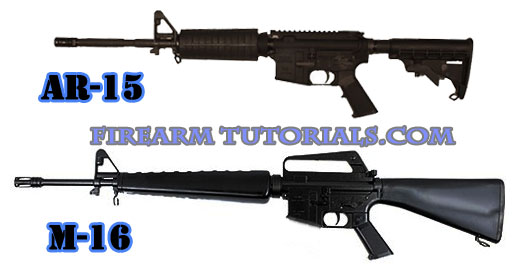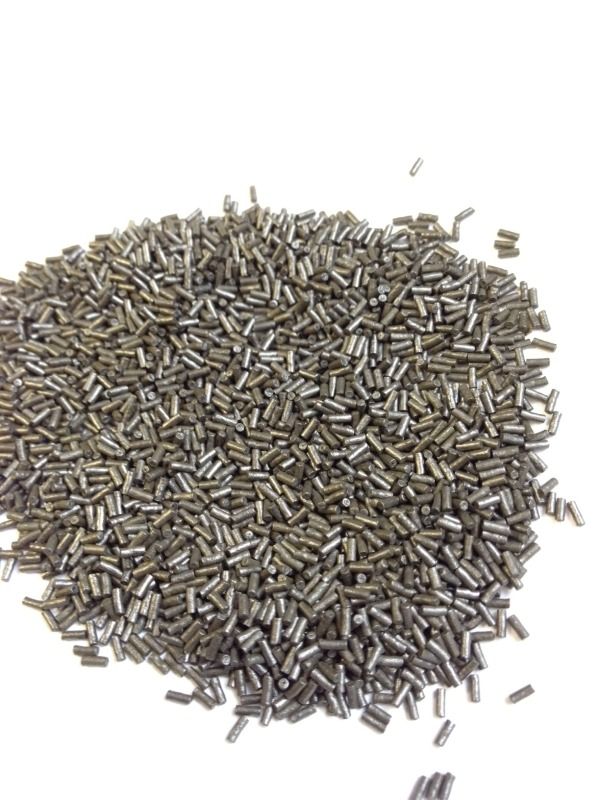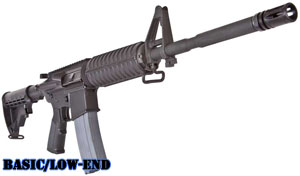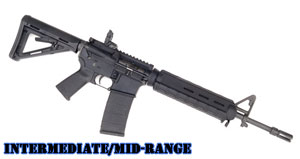Firearms in America
I do my best to provide unbiased information pertaining to different types of firearms, manufacturers, and laws. Certain sections of this site focus on specific areas and topics related to firearms. I only post information on topics and items that I can speak intelligently about. If I am not educated on a specific topic or item then you will not find it here.
Now for the disclaimers; I am not a gunsmith, lawyer, law enforcement officer, or gun control lobbyist. Nor do I play one on television. Any information contained on this site contains no warranty or guarantee of any kind. This site exists for the sole purpose of being useful to those who are less educated about firearms.
AR-15 vs. M16
There are many opinions and versions around the Internet about the actual differences between the M16 and AR-15. While the AR-15 was derived from the M-16, there several distinct differences. The M-16 saw wide-spread use in the Vietnam War. The original design was equipped with a 20" pencil profile barrel. It also had long rectangular hand guards and was capable of semi or full-auto fire.
The M16 had a full length fixed stock, and originally used a 20-round magazine. The upper receiver featured an integrated carry handle that also housed the rear sight. Several variants of the original design surfaced with popular features such as an 18" barrel (or shorter) and an adjustable stock.
So what is different about the AR-15? Several things were changed from the original M-16 design. Some were simply cosmetic and others were significant reliability improvements.
- Bolt carrier/trigger group
- barrel length/profile
- stock/hand guard
- gas system
- sights

The bolt carrier and trigger is constructed different because the AR-15 does not have a full-auto or burst trigger group. The AR-15 BCG has less mass than an M-16 carrier to reduce felt recoil. Although, there are many different bolt carrier designs present in the AR-15 today.
A thicker barrel profile was added the AR-15 as the original pencil barrel design over-heated quickly. In addition, the length was shorted to 16" while specialized models have barrels as short as 8".
The stock was changed to a 6-position adjustable version that accommodates shooters with a shorter arms or ones wearing body armor.
The gas system has also been shorted on the AR-15 models. The 18" and 20" barreled M16s used a rifle length gas system. Meaning the gas tube extended the full length of the hand guard which was closer to the end of the muzzle. AR-15 rifles commonly use a carbine length or mid-length gas system.
AR-15 rifles ditched the integrated carry handle in favor of a picatinny flat top receiver. The flat top allows for a wider variety of sights and optics. Some AR-15s will come with removable carry handles that attach to the the flat top.
If you are after a traditional M16, your options are limited. While there are still some manufactured as traditional M-16s, the original vintage models are usually found second hand. Some of the actual M16s used in the Vietnam war have actually been re-distributed to local and state law enforcement. A small amount exist in the NFA registry and are considered "transferable" for civilian ownership.
RELOADING: IMR 4064 not good for .223
With the shortage of smokeless gun powder, many people have resorted to using what is available for their reloading needs. I was lucky enough to score an 8 pound jug of Alliant Power Pro 2000-R a few months ago. Using "light" loads I am able to make good plinking rounds out to 100 yards with just 21 grains of powder.
Doing some math, that works out to roughly 2600+ rounds assuming some waste. Figuring I would eventually run out of it, I checked what I could find from my usual sources. I came across IMR4064 as a possible substitute. IMR claims it is one of their more versatile powders for .223 and .308. Here is some information that may be helpful if you are considering this powder:
- It's extruded powder
- It's low volume
Right off the bat, any reloaders using progressive presses may not even want to try the 4064 as extruded powders just do not meter  well. The amount provided by your powder drop may vary significantly using this or any other extruded powder.
well. The amount provided by your powder drop may vary significantly using this or any other extruded powder.
It's a low volume powder meaning you will need 25-26 grains to get a decent velocity if you are using standard 55 gr bullets. Packing the cases that tight my require you to change your bullet seating depth or crimp to compensate for increased pressures.
So who is this powder good for? Hand loaders using an automated power machine or scale that are loading .308 or .223 with heavier bullets. IMR suggests other uses such as .243 Win and even .338 Win Mag.
To date, my favorite powder for .223 is Hodgdon H335 which is a really nice ball powder that was more accurate (for me at least) than the 2000-R.
AR-15: cheap vs. expensive
If you are new to the AR-15 rifle scene or shop around for one you may ask yourself one question. What factors dictate such a wide range in price? The cheapest models can be had for right around $600. While a high-end or competition grade rifle usually starts around $2000 and depending on the optics upwards of $10,000. I will try to provide a concise explanation of the difference between cheap and expensive. Think of the difference between a Honda Civic and Ferrari F50. Both are cars, and both will get you from point A to point B. The Ferrari is built with more expensive materials and will obviously go faster, but if you aren't a trained race car driver you won't reap the full benefit of the F50.
The same is true regarding the AR. If you have never fired one before you probably won't appreciate the fully loaded $3000+ rifle. So what features/specs contribute to high-end ARs? There are several main components which drive the cost up:
- Barrel
- Hand guard (quad rail)
- Stock/grip
- Bolt carrier group
- Iron sights
- Trigger
- Luxury features
The aspects regarding the barrel are significant. There are many different types of barrels and they are also made from different materials.Your run of the mill standard M4 barrel with chrome lining is found on nearly all low to medium end AR-15s. High end AR-15s may have a different barrel profile which means the barrel is thicker. They also may be cold hammer forged (CHF) which is a more expensive process of creating a barrel which makes it more durable and extends barrel life.
may have a different barrel profile which means the barrel is thicker. They also may be cold hammer forged (CHF) which is a more expensive process of creating a barrel which makes it more durable and extends barrel life.
Match barrels on the other hand, are just as expensive bu will not have chrome lining present. They are often made from stainless steel. The rifling inside the barrel is more pronounced and designed to be more accurate. It is not uncommon for a CHF or match barrel to cost double or even triple what a standard AR-15 barrel would cost.
Hand guards, often called quad rails, are found on all high end rifles. The main purpose is accuracy as they are fastened very securely to the rest of the rifle. Most of them are "free floating rails" meaning they do not actually touch the barrel. This helps reduce the heat felt by the shooters hand and also provides a way to mount accessories such as lights, lasers, etc. Cheap ARs will have standard or modified plastic hand guards that snap in place, usually making direct contact with the barrel.
The stocks and grip also come in many flavors. Some high end stocks provide multiple points of adjustment, little to no wobble, and can hold accessories like batteries or sling mounts. Grips also vary in features as some have storage inside the grip for ammo or an extra bolt. Some also come with replaceable back straps to change the size of the grip.
Cheap AR-15s will come with a parkerized or phosphate bolt carrier group.  There is nothing wrong with it and for all intensive purposes they perform great. However, high-end ARs will usually come with a chrome, nickel boron, or a light weight bolt carrier group. These are generally used for competition or longer shooting between cleanings and usually run between $150-250.
There is nothing wrong with it and for all intensive purposes they perform great. However, high-end ARs will usually come with a chrome, nickel boron, or a light weight bolt carrier group. These are generally used for competition or longer shooting between cleanings and usually run between $150-250.
All AR-15s should come with a set of front and rear sights. Most of the cheap AR-15s will have the standard triangle type front sight with a fixed or plastic folding rear sight. In contrast, high end ARs will come with all metal front and rear flip up sights. While it may not sound like a big deal, these high end iron sight combos can run between $200-300.
Triggers are arguable as important as the barrel when it comes to accuracy.  The stock trigger that comes in most of the cheap or even mid-range ARs are terrible. A true match trigger will significantly improve accuracy for a experienced shooter. Most aftermarket match triggers cost between $200-300.
The stock trigger that comes in most of the cheap or even mid-range ARs are terrible. A true match trigger will significantly improve accuracy for a experienced shooter. Most aftermarket match triggers cost between $200-300.
Luxury features are things such as adjustable gas blocks, custom colors, and muzzle devices that can also add to the costs but again are usually geared towards competition or use with suppressors. Some will also allow the use of registered auto sears or lightning links to provide fully automatic fire.
If you are new to AR-15s a cheap model is still a good buy. Nearly all the $600 rifles are still mil-spec and will get your feet wet with the platform. It will also provide a baseline to gun upgrade and learn on. If by chance you don't like it or think it's too expensive to feed (ammo), you aren't out a ton of money.
 12/01/11 11:19:00 am,
12/01/11 11:19:00 am, 